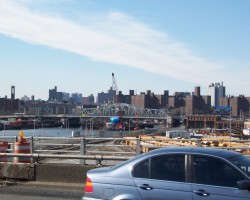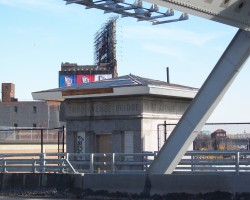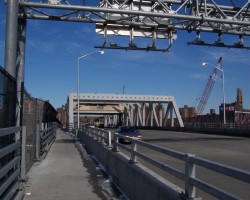Third Avenue Bridge
The Third Avenue Bridge connects southbound Third Avenue between the Bronx and Manhattan at 129th Street. The bridge features a 350-foot long swing span carrying five lanes of traffic and two pedestrian walkways. 17 approach spans give an overall bridge length of 1,500 feet and, including on-grade approaches, the total length is 3,500 feet.
This bridge is a replacement that was constructed between 2001 and 2007 and is the fourth bridge at the site.
The first bridge was built by John B. Coles on top of a dam that opened in 1797. The Coles Bridge was judged structurally deficient in 1859 and replaced in 1868 by a 526-foot cast-and-wrought iron bridge with a 218-foot swing span that provided a 52-foot wide roadway and two 80-foot wide channels in the river. Power to open and close the bridge was provided by water pressure from the Croton Aqueduct. The Morrisania and Fordham Railroad Company subsequently provided the first rail service over the Harlem River via this bridge.
The 1868 cast-iron bridge also soon proved to be structurally deficient and in 1892, the State Legislature allocated money for a new bridge. Construction began in 1893, with traffic diverted over a temporary timber span. The new bridge was designed by Thomas C. Clarke (who also designed the Willis Avenue Bridge) and opened to vehicles on August 1, 1898. Pedestrian sidewalks were installed in 1901. The original deck carried two trolly tracks which were removed in a 1928 reconstruction to improve automobile access. The bridge carried the Third Avenue El until the El was demolished in 1953 and the deck was reconfigured from four trusses to three trusses for two two-lane roadways. (NYCRoads)



